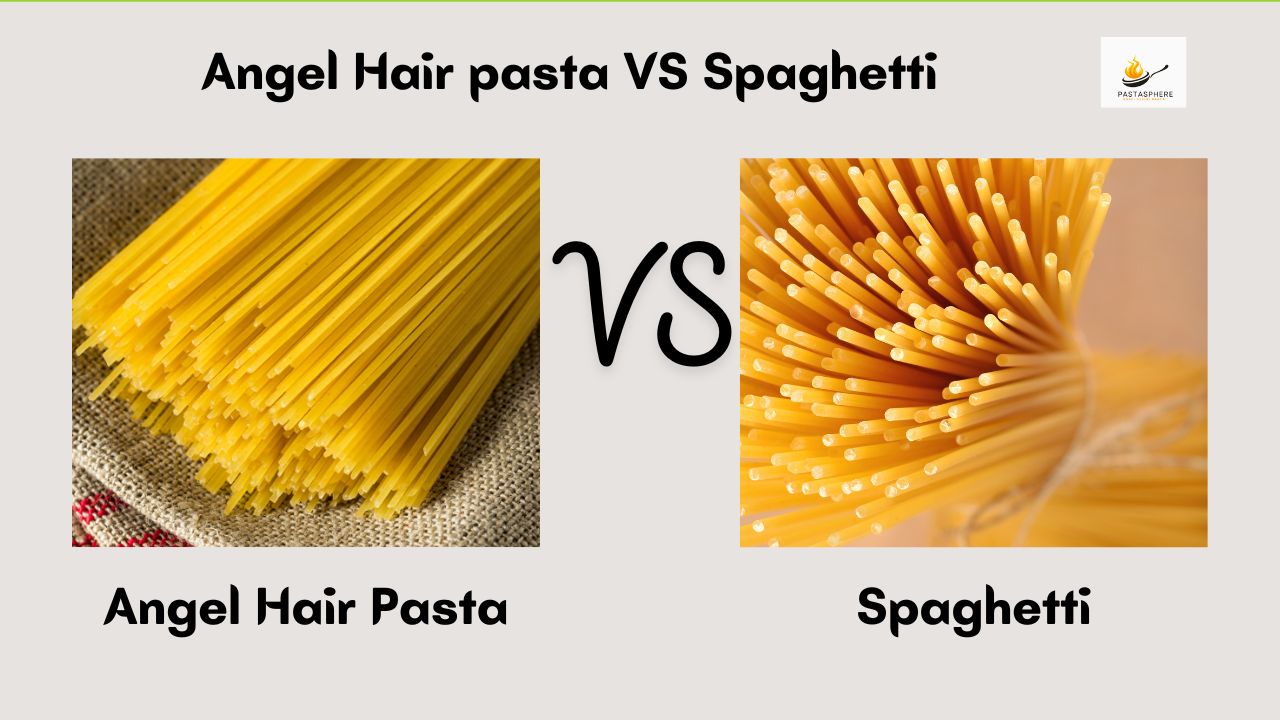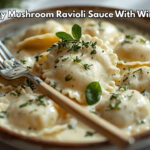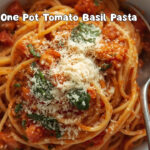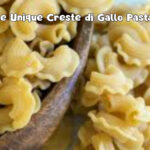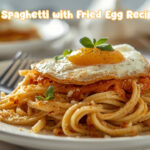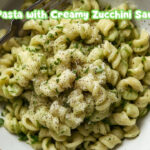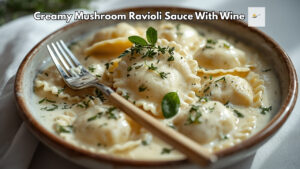Table of Contents
ToggleFor me, the debate “Angel Hair pasta vs Spaghetti “started when I was 11 years old and was on a long-haul bus trip. The bus had problems, and we had to stop in the middle of nowhere for enough time for them to feed us. The closest restaurant was a rustic place with maybe eight tables, and boom. There we were, the 30 passengers, eating whatever the kitchen would give us. And I had the only choice of selecting a soup with angel hair pasta. I wouldn’t say I liked it before because spaghetti was always my preference over it. But it was all I had this time, and I was starving, so I just ate it. And fell in love at first bite!
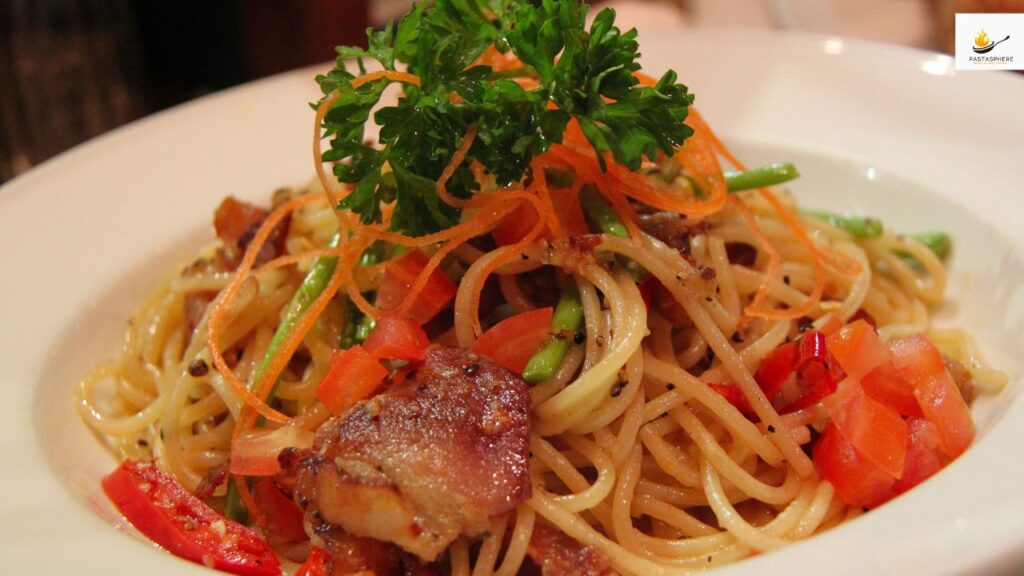
The texture of the pasta and its sauce can elevate the eating experience. After that, I started eating angel hair pasta in soups or with tomato sauce or cream sauce occasionally.
Angel hair pasta vs spaghetti each has a unique texture, taste, cooking method, uses, and devoted fans. Stay with us to explore their differences and get tips on selecting the ideal pasta type. Read on to discover all the details about angel hair pasta vs spaghetti, then select the best one that fits your preferences.
Angel Hair Pasta Vs Spaghetti: Understanding Origin
In Italy, angel hair pasta “like pasta crossword” is called “capelli d’angelo,” which means angel hair. It originated in Italy by resourceful cooks who used the smallest amount of dough to feed more people. This delicate pasta has thin strands and perfectly pairs with light dishes and simple sauces.
Spaghetti is the most popular pasta type worldwide and a staple in Italian cuisine. It means “little twine” or “string”. Spaghetti is versatile and pairs with heartier sauces to balance its hearty texture.
What's the difference between Spaghetti Vs Pasta? Take advantage of this!
Understanding “angel hair pasta vs spaghetti” by texture:
Matching the shape of your pasta to the dish significantly affects the outcome of your dish. Stay with us to understand pasta texture and how it pairs with sauces.
Angel hair pasta texture:
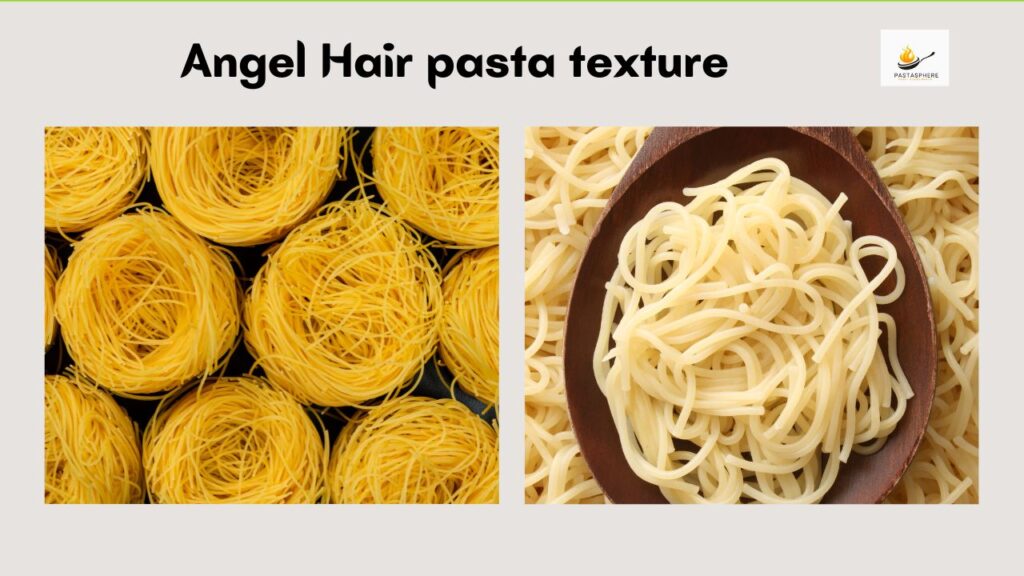
Angel hair pasta shape is famous for its fine texture. Its strands are very thin, around 0.78 to 0.88 millimeters in diameter. This delicate texture of angel hair like pasta crossword makes it unique among pasta varieties. Angel hair pasta can give a better texture since oil sauces don’t cause the pasta to clump.
Spaghetti texture:
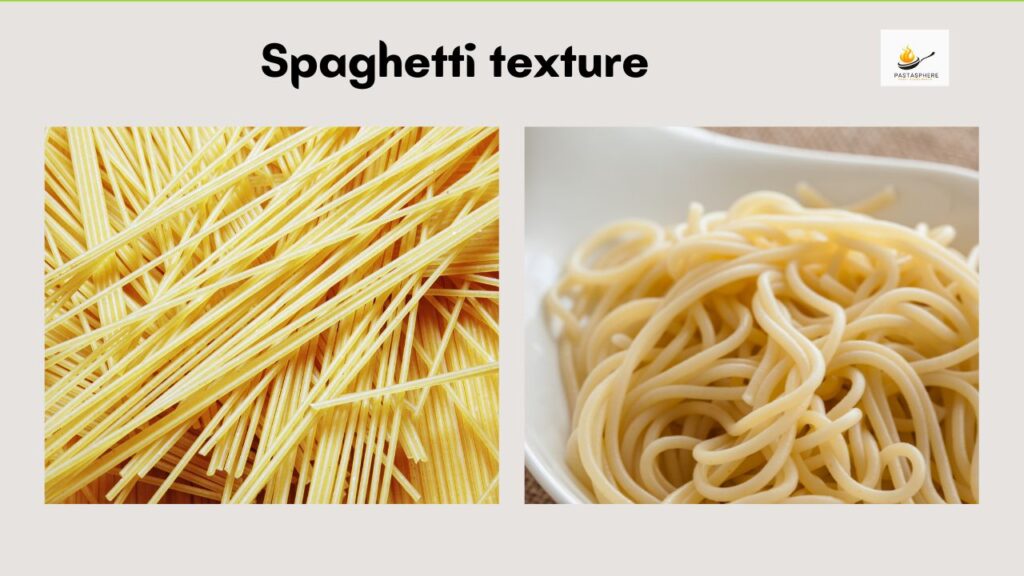
Spaghetti is the classic Italian pasta that has won people’s hearts worldwide. It is made with durum wheat semolina. Spaghetti is famous for its long, thin-cylindrical shape with nutty smells, and tastes delicious. One of the defining characteristics of spaghetti is its smooth and silky texture. This smoothness allows the pasta strands to absorb the sauce, and Carbonara, Bolognese, and Marinara sauces are ideal choices to pair up with spaghetti.
Importance of angel hair pasta spaghetti in Italian cuisine:
Italians love angel hair pasta spaghetti, but it is less universally popular than other pasta shapes like , penne, or fusilli. Some regions in Italy like it more because their traditional recipes prefer lighter pasta dishes. For example, in the coastal areas where seafood is a big part of the diet, angel hair pasta spaghetti is used more often as it pairs beautifully with delicate seafood sauces.
On the other hand, spaghetti is identified as refined and is loved by young and older people. Spaghetti is just the name of the specific type of pasta; the taste profile depends a lot on the sauce used. Spaghetti is a beloved dish that many people in the world enjoy, and it is a staple of Italian cuisine in particular.
How do sauces affect dish texture with angel hair pasta vs spaghetti?
Pasta shapes pair differently with sauces. The shape and thickness of the pasta determine how the sauce will adhere better to pasta shapes. Therefore, thinner sauces are usually paired with thinner pasta, such as angel hair pasta. Angel hair works best with oil-based sauces that coat each strand. Moreover, due to angel hair pasta thickness, blends better than spaghetti if it’s topped with fresh herbs or thin slices of cured meats.
Spaghetti has a vast surface unlike angel hair like pasta crossword , so it works well with thicker sauces that would not cut it with thick spaghetti strands. It pairs well, for instance, with aglio, olio, and peperoncino for a quick midnight meal. A chunky sauce with bits of sausage, eggplant, or zucchini doesn’t fit with spaghetti because you end up with separate bites.
Cooking difference between angel hair pasta vs spaghetti:
Angel hair pasta is unlike any other pasta and doesn’t cook like any other pasta. There is a specific way to cook this pasta. It cooks faster and is excellent at holding onto sauce. To cook angel hair pasta, take 1 or 2 cups of water in a skillet and add the pasta to it. The technique is just enough water that barely covers the pasta. Cooking in shallow water and moving pasta in a skillet develops a nice creamy, starchy water, which will be a part of the sauce.
The sauce usually sticks to pasta via starch (which is why you should add a little pasta water to the sauce and then finish the pasta in it). Angel hair pasta spaghetti is too thin to grip something like tomato sauce without becoming a clump. It works well with thinner, oily sauces: more macaroni per bite.
Spaghetti requires more time to cook than angel hair pasta. To cook spaghetti:
- Fill a pot with water and bring it to a boil.
- Once the water is boiling, add the spaghetti and some salt.
- Mix the spaghetti so it doesn’t clump.
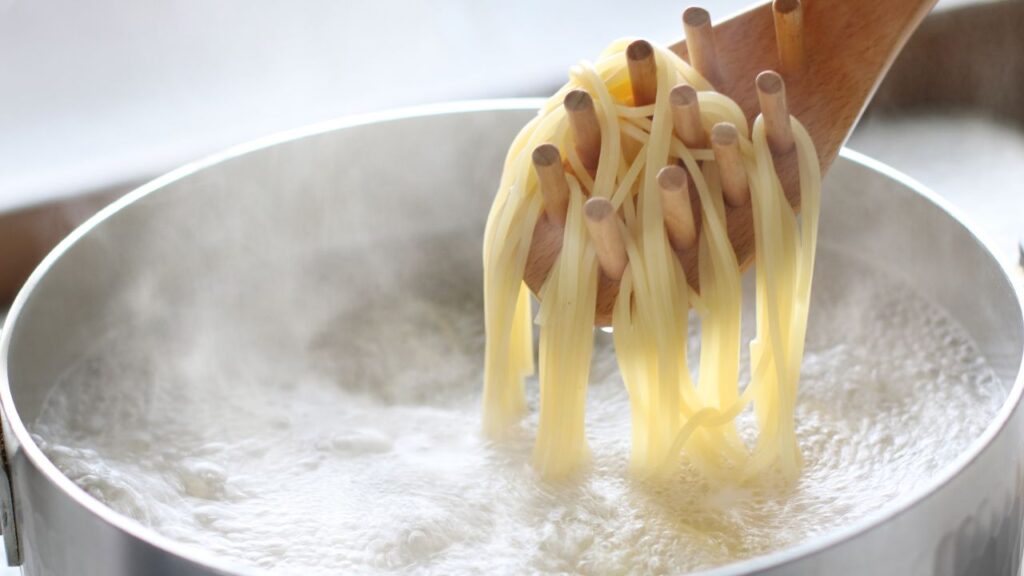
It takes 8-12 minutes. Check to see if it’s fully cooked or needs more time. Once it’s cooked, drain the excess water.
Nutritional value of angel hair pasta vs spaghetti:
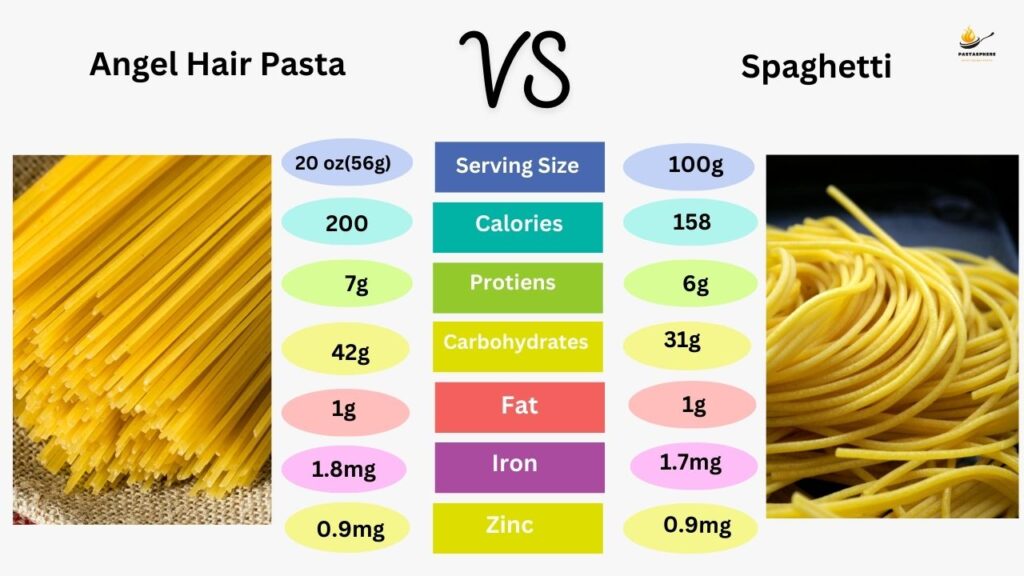
What are the health benefits of eating angel hair and spaghetti?

Regular pasta can be “healthy,” depending on your lifestyle and needs. Angel hair vs spaghetti are healthy options among other pasta types as they are both low in fats. Pasta has more protein and complex carbs, including meat and veggies like broccoli, capsicum, corn, etc. But covering them in a ton of alfredo or sugary tomato sauce doesn’t mean they’re still “healthy,” either. However, it’s essential to eat pasta modestly with the understanding that it will need to be worked off.
Health expert advice about angel hair pasta:
For those who have significant medical or operation-induced digestion problems, angel hair may be one of the few pastas they can enjoy without the pain of problematic digestion. It is a nice, light meal that mixes well with anything, and for an even smaller size, it can be cut cross-ways after cooking to make it eatable with a spoon.
Cultural adaptations:
Both angel hair and spaghetti are rooted worldwide due to their versatility and are used in various international dishes. Angel hair pasta is famous in Thai cuisine. Its thin, delicate strands resemble rice noodles’ texture and are used in dishes like pad Thai.
Spaghetti is often used in dishes that blend Italian and Korean flavors. Dishes like “Korean Spaghetti” show Korea’s ability to mix global ingredients into its cuisine while adding its unique twist.
Chef’s Recommendations:

Every traditional pasta type has a sauce that it’s best paired with. Angel hair is ideal for a light, fresh seafood dish or pesto-based sauce and feel free to use regular spaghetti as angel hair pasta substitute. However, spaghetti is more suitable for a hearty tomato sauce or meatballs because it carries the weight of the dish’s ingredients.
Final thoughts:
Both types of pasta are delicious and deserve a place in your kitchenette. Each pasta is shaped a certain way for a reason, and similarly, every sauce has an associated pasta to go with it. When we compare angel hair pasta vs spaghetti, the noticeable difference is the thickness of the pasta. The thinner texture of angel hair pasta often appeals more than thicker spaghetti. The thinness keeps angel hair dishes from being bland and clump and pairs well with lighter sauces. Spaghetti goes well with thick sauces, like alfredo and red sauce.
However, spaghetti wins against angel hair pasta. So, there are better choices for those who monitor their carbs. If you’re craving pasta, choose spaghetti over angel hair pasta shape.
Frequently asked questions
Is angel hair the same as spaghetti?
Angel hair pasta is a thin, long noodle resembling spaghetti. But angel hair is much more delicate, and this fine-textured pasta is ideal for pairing with light sauces and vegetables, such as pesto sauce.
Does angel hair pasta cook faster than spaghetti?
Due to its size, angel hair pasta cooks more quickly than any other type of pasta. While spaghetti cooks in about 8 to 10 minutes, angel hair pasta cooks in about 3 to 5 minutes.
Can I substitute angel hair pasta for spaghetti?
Sure you can! I like angel hair thinner pasta for noodle soup or stir fry! One can substitute linguine, vermicelli, angel hair, or pasta. The determining factor would be the type of sauce it is served with.

